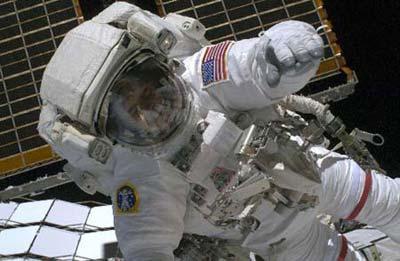Source: Xinhua
03-23-2009 10:45
Special Report: Tech MaxWASHINGTON, March 21 (Xinhua) -- Two astronauts from U.S. spaceshuttle Discovery's seven-member crew completed the second of three planned spacewalks Saturday to make preparation for NASA's future space shuttle mission and the debut flight of a Japanese cargo ship.
 |
| Space shuttle Discovery crew member Steven Swanson works outside the international space station during a space walk orbiting Earth, Thursday, March 19, 2009. Astronauts aboard the U.S. space shuttle Discovery unfurled the International Space Station's fourth and final set of solar array wings, bringing the 10-year-old space station to full power, which is critical for boosting science research and allowing the crew to double to six.(Xinhua/AFP Photo) |
The NASA TV shows that Steven Swanson and Joseph Acaba exited the space station at around 0:51 p.m. EDT (1651 GMT) to start the outing, which lasted about six and half hours. It's Swanson's fourth spacewalk of in his career and Acaba's first.
Their primary job is loosening connections on batteries on the external Port 6 truss, ready for their replacement on a later mission in June.
The two also installed a GPS antenna to the outside of the station's Japanese module. The GPS device will help guide the Japanese HTV robotic spacecraft, a cargo transfer vehicle to be put into operation later this year.
The autonomous craft will supply the station's Kibo laboratory with water, food and scientific materials, and could also resupply the rest of the station if needed.
Other tasks include: outfitting the station's truss with attachments for experiments and cargo platforms; using an infrared camera to photograph radiator panels so engineers can assess how they have withstood the harsh space environment.
